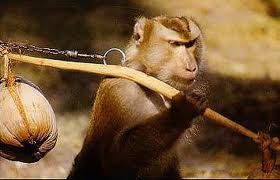 Are you suggesting that coconuts migrate? (Monty Python)
Are you suggesting that coconuts migrate? (Monty Python)
Well, silly Monty Python, of course they do. Using the oceans to spread their huge coconut seeds (each fully grown one weighs approximately 4.4 kgs / 3.2lbs) the coconut palm has populated vast areas of the topics. Some seeds have even been found off the Norwegian coast.
The palm – cocos nucifera – needs high temperatures (above 12 degrees every day of the year), lots of sunshine, regular rainfall and humidity in order to survive, and nothing growing above it – that’s why we don’t see it in Europe as a growing species, and why it first flourished along empty coastlines. It loves sandy soils, and can obviously tolerate high salinity. It can grow as high as 30 metres and produces between 30 and 75 fruits a year, and when very carefully cultivated, sometimes more.
Defying gravity at times, it seems to be able to continue growing even when leaning at 45 degrees or more, despite relying on a fibrous root system, with no big tap root or root hairs.
And of course, as soon as man realised how beneficial this plant is he intervened to give it a helping hand in establishing itself, and seafarers of long ago would transport the nuts for cultivation. Over 80 countries now grow coconut palms, not only for their beauty and decorative value but because almost every part of the tree and its seeds can be used. Its various names in local languages hint at this: kalpa vriksha (Sanskrit) means ‘the tree which gives the necessities of life’; pokok seribu guna (Malay) ‘the tree of a thousand uses’; and in the Philippines it is ‘the tree of life’.
Coconut timber and the huge leaves from the palm can be used for building and furniture making. The timber is water resistant, and produces good, straight timber.
Coconut water – the sweet juice from the nut – is a refreshing drink, and is growing in popularity as an isotonic sport drink because of the natural ingredients, including protein, anti-oxidants, minerals and vitamins.
Coconut flesh – the white flesh or meat from the nut can be used fresh or dried, made into flour or chips, and is widely used in both savoury and sweet dishes.
Copra – is the dried meat of the seed, and from this comes coconut oil and coconut meal.
Coir – the fibre from the coconut husk, has a myriad of uses: ropes, brushes, sacks, mats and stuffing for various household furniture and furnishings.
Coconut milk and cream – produced by infusing the coconut flesh (either fresh or dried) in hot water or milk.
Coconut toddy, nectar, palm wine, palm sugar – all drinks, fresh or fermented, produced from the palm flower sap.
Coconut vinegar – produced from the coconut water.
Heart of palm – a rare delicacy, as using the young buds kills the parent palm.
Coconut sprout – from newly germinated seeds, which produce an edible substance of a fluffy consistency, a bit like marshmallows.
Coconut root – can be used to produce a mouthwash, medicine for dysentery and diarrhoea, and a dye. You can also use a frayed piece as a toothbrush!
What a plant!
Thailand is the 6th largest producer of coconuts in the world. In 2009 it produced 1.7million tonnes.
In some places in Thailand, coconuts are harvested by trained monkeys (pig-tailed macaques) called ling gaeng. The monkeys climb the trees, pick the coconuts and throw them down to their handler. These monkeys are trained in special schools, and the best will take part in competitions each year to find the quickest harvester.
Coconuts can be harvested every 40 – 90 days, depending on how good their growing soil is and how quickly that particular tree is producing fruit, so with luck, when you visit Koh Samui, several farmers will be gathering in their produce. It’s great fun watching the men run up the trees and cut down the seeds – just be careful to stand well back! And if you’re lucky and find a farmer who uses the monkeys, you will have a great photo opportunity.